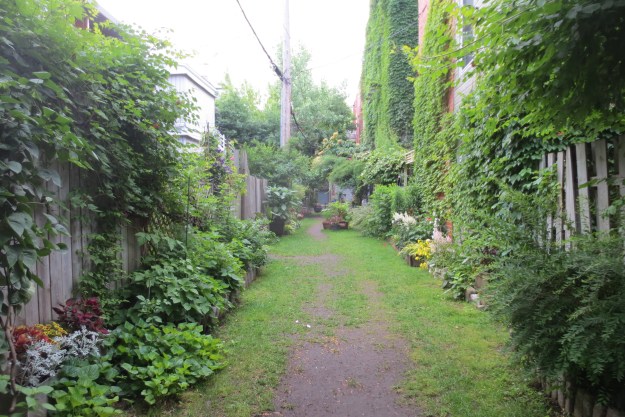The LePlateau neighbourhood and surrounding areas that comprised the high density urban expansion in the 1870’s – 1920’s often had “back lanes”. These accessed the rear yards of the houses, most of which are duplexes and triplexes. They had spiral metal staircases that so captivate the “look” of these neighbourhoods, in the rear yards too.
It is possible to use the lanes to access car parking in some back yards. But most yards are too small, are too valuable as living space, or parking spaces were unneeded, or houses expanded ramshackle-ly into the space. Les Ruelles Vertes are lanes that have been formally / legally converted into either car free or severely limited to car access.
They make fabulous green spaces and children’s play spaces, or a way to get your bike off the street. And there is the whole “greening the city” aspect, stormwater management role, heat reduction, privacy in a high density area, etc.
It is almost as interesting to walk the back lanes as to admire the fronts of the houses. Revise that: it is definitely as interesting …
Let’s get to the pictures !
First, a ruelle vert under conversion from asphalt to greenery. The City provides the engineering, the landscape architecture plan, and a professional gardener, but volunteers do the planting ! Sweat equity builds ownership.
Once the asphalt is gone, planting beds are dug:
Here’s a finished lane, a very narrow one, that is still partly open to some cars to access rear yard parking. Note that the car access prohibits trees growing in the actual lane.
The view into the back lane of my apartment balcony was so thick with trees we could only get the slightest peeks over to neighbouring balconies:
Actually, hidden in that picture is a historic artefact. Let’s look closer:
It’s the top of a communal clothesline pole. Look how thickly the trees have grown up around it. The whole back lane was this thick. But it is not the way the neighbourhood always was. I took this pic off a display in the public library building, from the 1950’s:
There were no / few trees, clothes drying being way more important. Due to the slippery metal winding staircases, scrap wood was frequently used to enclose them, to store working materials and tools, and maybe even to dry clothes during inclement weather. Most of the ticky tackiest ones are gone, which much opens up the back yards to light and air and makes way for vegetation, but some stairs can still be found.
Here’s two pictures of a green lane conversion from a Montreal friend, of a lane she was gardening in:
That’s the back of an abandoned building on the right, pending design approval for a new building on that site.
Does Ottawa have back lanes? You bet ! Are they greened? Some are. Some aren’t. Do we have a program or plan for these?















Wonderful reportage of a creative phenomenon I was not aware of.
In St. Lambert (A suburb across the river from down-town Montreal) in the 70’s we also had narrow gravel lanes for rear access.. The city decided to sell off these slices of real estate to the adjoining owners, for a nominal amount. This wa possible in an essentially single family district and was likely the right solution under the circumstances. What Montreal is doing is quite creative, and one may hope that the neighbors will maintain the planting, as it will need attention eventually. It will be interesting to see what happens in the winter. Vehicular access is of course eliminated as it seems form the photos.